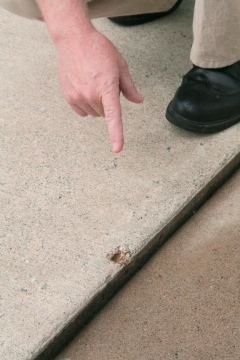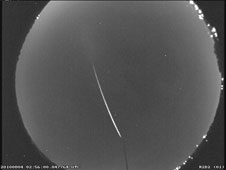
© VICKI TERWILLIGER/staff photos
Hegins - Whatever struck Ralph Lucht's home in Hegins punched a hole through asphalt shingles and the flashing on the roof.
Lucht believes a meteorite may have struck his Pine Drive home at the end of July or beginning of August.
The metal of the white flashing is peeled outward several inches, as if it had suffered a tremendous force or heat.
A cable to a lighting rod on the roof was also severed by whatever apparently fell from high above, Lucht said. It grazed the edge of the cable, barely missed entering the house, then landed in a solid concrete patio surrounding Lucht's pool.
The indentation in the concrete was about one-inch-by-one-inch wide and a half-inch deep. Inside the hole was rust-colored flecks of material.
"The flecks were magnetized. It had to be a projectile," Lucht said. "I looked around for parts, but didn't find any," he said of whatever had made the depression in his patio.
The family did not hear anything, but recently noticed the damage when they went outside. Lucht does not believe the damage could have been caused by a stray bullet.
His home is in a mountainous region in a wooded area in Hegins Township with no homes in close proximity. Hegins Township had no other recent reports of similar damage, according to Supervisor Vicki Harman.
